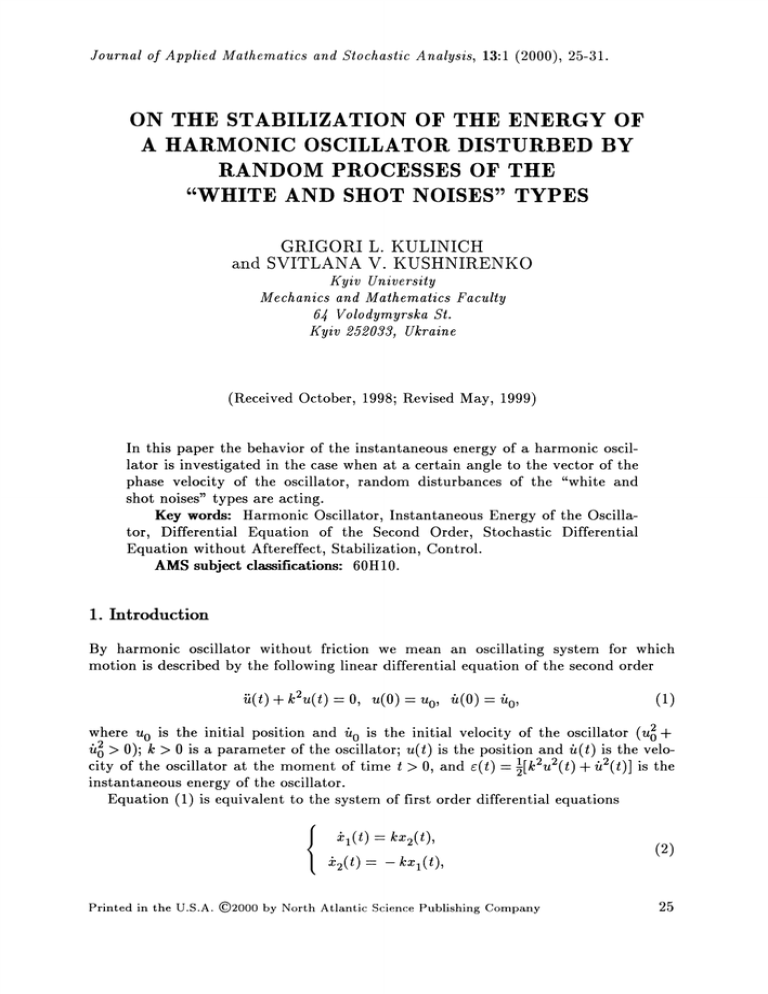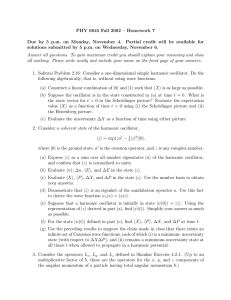THE A BY "WHITE
advertisement

Journal
of Applied Mathematics
and Stochastic Analysis, 13:1
(2000), 25-31.
ON THE STABILIZATION OF THE ENERGY OF
A HARMONIC OSCILLATOR DISTURBED BY
RANDOM PROCESSES OF THE
"WHITE AND SHOT NOISES" TYPES
GRIGORI L. KULINICH
and SVITLANA V. KUSHNIRENKO
Kyiv University
Mechanics and Mathematics Faculty
6 Volodymyrska St.
Kyiv 252033, Ukraine
(Received October, 1998; Revised May, 1999)
In this paper the behavior of the instantaneous energy of a harmonic oscillator is investigated in the case when at a certain angle to the vector of the
phase velocity of the oscillator, random disturbances of the "white and
shot noises" types are acting.
Key words: Harmonic Oscillator, Instantaneous Energy of the Oscillator, Differential Equation of the Second Order, Stochastic Differential
Equation without Aftereffect, Stabilization, Control.
AMS subject classifications: 60H 10.
1. Introduction
By harmonic oscillator without friction we mean an oscillating system for which
motion is described by the following linear differential equation of the second order
(t) + 2(t)
o, (o) o, (o) o,
(1)
where u 0 is the initial position and /t 0 is the initial velocity of the oscillator (u0 +
/t0 > 0); k > 0 is a parameter of the oscillator; u(t)is the position and/t(t) is the velocity of the oscillator at the moment of time t > 0, and (t)
2u2(t) / /t 2(t)] is the
instantaneous energy of the oscillator.
Equation (1) is equivalent to the system of first order differential equations
[kl
(2)
Printed in the U.S.A.
()2000 by
North Atlantic Science Publishing Company
25
G.L. KULINICH and S.V. KUSHNIRENKO
26
where
]ctt(t),x2(t
Xl(t
it(t).
In addition, 2c(t)-]x(t)] 2, where x(t)-
In the present paper we investigate the behavior of instantaneous energy c(t) in
the case when, at a certain angle to b (kx2(t),- kxl(t)) where b is the vector of the
phase velocity of system (2), fluctuations of the "white noise" type (tb(t) is a
"derivative" of a Wiener process w(t)) and fluctuations of the "shot noise" type
(/([0, t),R) is a "derivative" of a Poisson measure u([0, t), R)) are acting. In this case
system (2) is considered as the following system of stochastic differential equations
without aftereffect (see [2]):
dx(t)
a(t, x(t))dt -+- b(t, x(t))dw(t) +
/ c(t. x(t). u).(dt, du).
R
where
X
a(t.x)
(ql(t.x)xl q- q2(t.x)x2. -q2(t.x)xl / ql(t.x)x2).
(Xl, X2) E / X R, x 1(0)
k/to, x2(O -/to,
(gl(t.x)xl + g2(t.x)x2.
b(t.x)
C(t,X, U)
(71(t, x, U)x
g2(t.x)x I -k- gl(t.x)x2).
q- /2(t,x, u)x2)
72(t,X, u)x I q- ")’l(t,x, U)X2)
R is a non-random vector function, w(t) is a one-dimensional Wiener process,
u([0, t),A)) is a Poisson measure with parameter tII(A), such that II(R)< oc. The
process w(t) and the measure u([0, t),A), are defined on the probability space
(f,F,P). They are jointly independent and Ft-measurable for any t _> 0 and A,
uE
where F C F is a nondecreasing family of (r-algebras.
Qualitative analysis of the behavior of the harmonic oscillator without friction
under the random perturbation along the vector of the phase velocity by stochastic
process of the "white noise" type is made in paper [5] and qualitative analysis of the
behavior of the harmonic oscillator with friction is made in paper [6]. Book [8] gives
a formula for the fundamental matrix for linear equations of type (3) with varying coefficients. For equations with constant coefficients, conditions are given under which
[x(t)[0 with probability 1 as tc as well as conditions under which
EIx(t) 12--,O as t--<x. The behavior of the instantaneous energy of the harmonic oscillator under the random perturbation only of the second component of the vector of
the phase velocity was investigated by many authors (see, for example [3, 4, 7, 9]).
In the present paper, we investigate the sufficient conditions under which the instantaneous energy does not change: e(t)- e(0) (Corollary 1 of Theorem 1), the sufficient conditions under which the instantaneous energy e(t) changes only step-wise
(Theorem 2), as well as the sufficient conditions of stability e(t) (Theorems 3-5) are
established for equation (3) in terms of functions qi(t,x), gi(t,x), 7i(t,x,u). It is
shown that it is possible to control the behavior of e(t) by the choice of function
ql(t, x) (determined disturbance).
We will assume that functions qi(t,x), gi(t,x),
of equation (3) satisfy the conditions:
C > O: a(t,x)
2
7i(t,x,u)
are such that coefficients
+ b(t,x) -4- f c c(t,x,u) 12II(du) < C[1+ Ix 12];
Harmonic Oscillator Disturbed by Random Processes
27
a(t,x)-a(t,y) 2 -4- b(t,x)-b(t,y) 2 + f c(t,x,u)c(t, y, u) 12II(du) < CNlX- y[2 with Ix < N, Yl < N;
VN >
OCN:
n{:
Ix + c(t, z, )1
o fo n t _> o, I. # o.
o}
It is known (see [2]) that conditions 1, 2 guarantee existence of the unique
continuation from the right strong solution x(t)- (xl(t),x2(t)) of equation (3).
In addition, we will use the following designations"
v (t, 4)
,(t, 4) tn(4);
2
2ql(t, x) + g2(t,
x);
I(t, x)
I(t,.) + l(t, );
(t, )
2 t
,x,
(1 + 71(t,x, u)) 2 + 72(
(t,x, u)
2. Stabihzation of e(t)
According to the generalized Ito’s formula (see
d
Ix(t)] 2
[2])"
[2(x(t),a(t,x(t)))+ b(t,x(t))]2]dt + 2(x(t),b(t,x(t)))dw(t)
+
J
[I (t) + c(t, (t), )
x(t) ],(t, ,1,
R
where
(.,.)
is the inner product.
Thus,
d
lx(t)] 2
Ix(t)
+
J
12{Ii(t,x(t))dt +
[(t,x(t), ) ].(dt,
R
Condition 3 implies that
2gl(t,x(t))dw(t)
(t,x,u)> 0
in measure
(4)
d)}.
II(du)
for all t> 0, x. Therefore
(see [8])"
x(t) 12
x(0) 12ex
I2(s,x(s))ds + 2
o
gl(s,x(s))dw(s)
o
}
Relations (4) and (5)imply the following statements.
Theorem 1: If for all > 0 and x
()
G.L. KULINICH and S.V. KUSHNIRENKO
28
(1)
(2)
then
gl(t,x)-0;
II{u" (t, x, u) # 1 ) 0,
with probability 1 for all t >_ 0
the following inequality holds true"
f ,() <
(o)i
<
(t)
(o)i
f M(),
where
inzfI(t,x ), M(t) -supI(t,x).
x
rn(t)
Proof: Therefore, in this case relation
Ix(t)
(5) takes the form
Ix(O) 12exp
2-
{(
I(s,z(s))ds
}
which implies the statement of Theorem 1.
Remark 1: Condition (1) means that system (2)is perturbed by "white noise"
only along the vector of the phase velocity. It follows from condition (2) that
c(t,x, u)
2(x, c(t,x, ))
2
<0
Ix
in measure n(d=) for all t > 0,
:/: 0. Thus, condition (2) means that system (2)
is perturbed by "shot noise" at an obtuse angle to the radius-vector.
Corollary 1: Under conditions (1) and (2) of Theorem 1 it is possible to control
the behavior of e(t) of a perturbed system by the choice of function ql(t,x) (determin-
disturbance). For example"
(1) if 2ql(t,x) -g22( t, x), then e(t) (0) with probability 1 for all t _> O;
(2) if f toM(s)ds < C, then e(t) < e(O)e c with probability 1 for all t > O;
(3) if2ql(t,x)- -g22(t x)+ Co, then (t)- (o)eCt; etc.
2
Theorem 2: If 7i(t,x, u) 7i(t, u),
1,2 and gl(t,x) O, 2ql(t,x + g2(t,x)
for all t >_ 0 and x, then
ed
/
(t)
()
x(0)
2
I-I
’k<t
where 0
{uk}
< 7"1 < 7"2 <
’
if t < 7"1,
if 7"k <-- t < 7"k + 1’
(7"k, Uk),
are shock-points
of a
Poisson process
u([O,t),R)
0
(6)
and
v({7"k}
1, k- 1,2
Proof: Therefore, under the conditions of Theorem 2, relation (5) takes the following form:
x(t)
=
x(0) 12exp
ln(s,u)v(ds, du)
0
R
which implies equality (6) (see [2]).
Corollary 2: Under the conditions of Theorem 2, e(t) changes only step-wise:
moreover, shocks take place only in the moments of impulse disturbance, that is, in
the moments of jumps of a Poisson process v([0, t),R).
In particular, if
Harmonic Oscillator Disturbed by Random Processes
(1 + ")/1 )2 + 3’22
is a constant magnitude, then
x(t)
Remark 2: If II{u: (1
2
x(0) 2[( 1 + ")’1 ) ’2]2 u( (o, t], ).
2
u) 7 0}
+ 71(t, u)) 2 + 72(t,
i(t)
-_
29
le_{
Ix(0) 12’
0,
0 for all t
_> 0,
(7)
then
ift<71,
if 7-1
(8)
t.
This means that under the first impulse disturbance, the considered system moves
into the equilibrium state and does not leave it with probability 1. Thus in this case
with small disturbances of coefficients 7i(t,u), it is possible to achieve equality (7)
and then obtain (8) by passing to the limit.
Theorem 3: If for all t >_ 0
then
P{ t_>oSUp (t)
u
any 1 > O, 2 > 0 as soon as Ix(O)[ < 6; 5 > O.
Proof: Formula (4) implies the following equality:
for
where
(t)
2
/ gl(s,x(s))dw(s) + / [(s,x(s), u)- 1] (ds, du).
o
o
Therefore, with probability 1 for all t _> 0
x(t)
Since
q(t) is
a square
(0)
+ (t).
integrable martingale, then from the inequality
(9)
(9)
we have
(see
[1])"
P{ t_>oSUpr](t)gl}_
The statement of Theorem 3 follows from
Theorem 4: If
(1)
o
(9)
and
I(O)1 =
(10).
(10)
G.L. KULINICH and S.V. KUSHNIRENKO
30
> 1/2; and
for some
lhen
{limt__,o Ix(t)[2-0}- 1.
P
Proof: Hence, we can rewrite equality
(5)
as
ix(t) 12_ ix(o) 12exp t t-1
I(s, x(s)) +
0
(11)
where
0
0
According to Condition
with probability 1
(1)
R
of Theorem 4, we will find 5
> 0 and
0 > 0 such that
I(s,
t--a
R
0
T.
Furthermore, since (t) is a square integrable martingale with characteris>
tics which satisfy the following inequality"
as t
Reasoning similarly to [4, Lemma 7.1], it can be proved that
P
{tlimt-C(t)- 0}-1.
Therefore, taking into account (11),
Theorem 5:
If for all >_ 0
and
I(t,x)+
we obtain the statement of Theorem 4.
x"
/[(t,x,u)- 1]II(du)- Q(t)
R
and
lim
t--(x)
/ Q(s)ds
0
then
-
Harmonic Oscillator Disturbed by Random Processes
lime
Proofi
Hence, from
relation
(4)
(t)
a(t)
we have
z(0)
+
J
31
O.
() () d"
0
Therefore,
E x(t)
12
(0)12 f
This equality implies the statement of Theorem 5.
Remark 3: If the system is perturbed by "centralized shot noise"
([0, t),A)is a
"derivative" of a Poisson nature) instead of "shot noise" and other perturbations are
fixed then only the orientation of a(t,x) changes in equation (3), that is,
(
a(t,x)- (’l(t,x)xl +2(t,x)x2,-2(t,x)x I +’l(t,x)x2)
where
’i(t, x)
qi(t, x)
/ 7i(t,
x, u)H(du).
R
References
[1]
[2]
[3]
[4]
[5]
[6]
[7]
[8]
[9]
Gikhman, I.I., Differential equations with random functions, Winter School on
the Theory of Probability and Math Statistics (1964), 41-85.
Gikhman, I.I. and Skorokhod, A.V., Stochastic Differential Equations and Their
Applications, Naukova Dumka, Kiev 1982.
Gikhman, I.I. and Skorokhod, A.V., The Theory of Stochastic Processes, III,
Nauka, Moscow 1975. English Trans. Springer-Verlag, Berlin 1978.
Khasminskii, R.Z., Stability of Systems of Differential Equations under Random
Perturbations of the Parameters, Izdat. Nauka, Moscow 1969. English Trans.
Kluwer Academic Pubs., Norwell, MA 1980.
Kulinich, G.L., Qualitative analysis of the influence of random perturbations on
the phase velocity of the harmonic oscillator, Random Operators and Stoch.
Eqns. 3:2 (1995), 141-152.
Kulinich, G.L., Qualitative analysis of the influence of random perturbations of
the "white noise" type along the vector of the phase speed on the harmonic oscillator with friction, Ukrain. Math. J. 49:1 (1997), 36-47.
Kulinich, G.L., On the limiting behavior of a harmonic oscillator with random
external disturbance, JAMSA 8:3 (1995), 265-274.
Skorokhod, A.V., Asymptotic Methods in the Theory of Stochastic Differential
Equations, Naukova Dumka, Kiev 1987. English Trans. Translations of Math.
Monographs 78, AMS, Providence, RI 1989.
Stratonovich, R.L., Selected Questions in the Theory of Fluctuations in Radio
Engineering, Soviet Radio, Moscow 1961.






